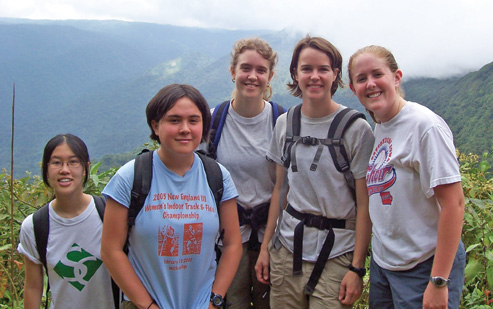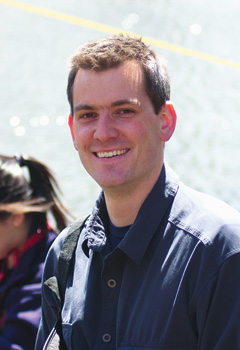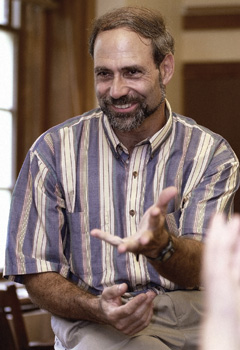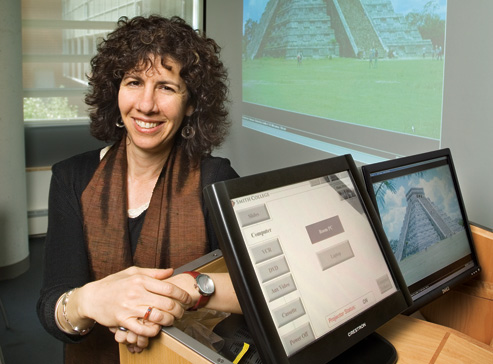Why Research Matters
at a Liberal Arts College
By Jan McCoy Ebbets
In the low-visibility, moisture-dense cloud forest of
Monteverde, Costa Rica, it didn’t take long for Smith College professors Amy
Rhodes ’91, a geochemist, and Andrew Guswa, a theoretical hydrologist, to clearly
see the rich opportunities for hands-on teaching and collaborative research.
Straddling the Continental Divide and nearly five thousand
feet above sea level, the forests of the world-famous Monteverde Cloud Forest Preserve
are continually bathed in the clouds and fog that glide in from the Pacific Ocean.
The unique cloud forest is home to more than one hundred species of mammals and many
endemic species, including epiphytes, amphibians and birds; its fast development
into a major tourist destination, drawing some 60,000 visitors a year and more than
200,000 to the region, is threatening that ecosystem.
Since January 2002, nearly a dozen Smith undergraduates
have accompanied Assistant Professor of Geology Rhodes and Assistant Professor of
Engineering Guswa to Costa Rica, with scientific equipment in tow, for ongoing hydrologic
and geochemical studies of the cloud forest region.
Such research opportunities are now an increasing part
of undergraduate education, whether for science and engineering, arts, humanities
or socials science majors. The work can be independent or collaborative; it can be
in the form of a special studies project or an honors thesis. Most important, it
makes an original intellectual contribution to an academic discipline.
Smith is one of a number of institutions around the
country to increase opportunities for student-faculty research collaborations in
the past decade, motivated by a report issued in the late 1990s by the Carnegie Foundation
for the Advancement of Teaching calling on colleges and universities to involve more
undergraduates in research.
In the cloud forest study, says Rhodes, “The
research benefits tremendously from student involvement.” Undergraduates work
alongside Guswa and Rhodes, maintaining collection stations and gathering data to
answer such questions as: How does precipitation vary in time and space along the
Pacific slope? Does vegetation cover affect the hydrologic inputs to a watershed?
What is the impact of development on water quality and distribution?
And like many other college students given the opportunity
to do original research in an exotic landscape, these students are mindful of a desire
to make contributions to the scientific field in which they work while they realize
their own benefits from the experience.
“Since much decision making was on our shoulders,” recalls
engineering major June Yeung ’07, “the (team) really had to work together
to figure out what to do and what was best for the project. This responsibility fostered
a sense of ownership [of] the project; we had to be constantly aware of the goals
of the research…. This experience has exposed me to the excitement of research
and made me less afraid of the unknown.”
Another undergraduate who embraced the excitement of
research while working in the preserve was biogeochemistry major Silvia Newell ’04.
She spent two summers there before graduating from Smith and winning a Fulbright
fellowship to study in Costa Rica.
“Working on this project had made me seriously
consider devoting my career to the study of water: water movement, water quality
and water supply,” she wrote for an evaluation after her first summer in Monteverde.

“Team Agua” in the scenic Monteverde Preserve
summer 2005 included four Smith students, from left, June Yeung ’07, Mai Kobayashi ’06,
Merilie Reynolds ’08 and Ilona Johnson ’06. Erin Cavanagh, far right,
from the University of Iowa, also helped on the Smith project while completing an
eight-week internship at the Monteverde Institute.
“I have learned lab and field methods that will
be useful in the future, and I have added another level to my ability to think like
a scientist. The deepest level of understanding this experience has given me, though,
is through two role models [Rhodes and Guswa] who have offered me a view of what
it means to live as a scientist,” said Newell, who is now working on her doctorate
in geosciences.
Meanwhile, Rhodes and Guswa continue to incorporate
discussion of statistical data representation and environmental issues raised by
their cloud forest study into the geology and engineering courses they teach on campus.
They aim to use their ongoing investigations to test hydrology and geochemistry models
for Monteverde in hopes of steering future development of buildings and paved roads—and
other surfaces that will replace soil and plants and perhaps adversely affect the
natural process of the area’s water cycles—toward sustainability.
Ongoing studies show that benefits to students
from a collaborative research experience include a better understanding of appropriate
methodology, intensive exposure to a research problem, ability to analyze data and
communicate results and a clarification of career plans. Through the work, students
can experience firsthand the processes of scholarly inquiry and an intellectual life,
the good and the bad, the wonder as well as the drudgery.
No one would argue with the idea that such hands-on
experience, with the ups and downs of genuine scholarly research, is invaluable to
students, whether their aim is to enter graduate or professional school or simply
to apply and improve critical thinking skills.
One of Smith’s greatest strengths is a collegewide
commitment to offering undergraduates abundant opportunities to engage in research
projects with faculty.
 |
 |
 |
 |
 |
 |
| Drew Guswa, assistant professor of engineering |
 |
Roger Kaufman, professor of economics |
At the Kahn Liberal Arts Institute at Smith, students
can get a taste for the pure pursuit of scholarship and intellectual debate. Each
year students may apply for fellowships to work alongside professors and visiting
scholars in interdisciplinary research projects. Whether exploring the relationship
between form and meaning in poetry or considering the effects of public relations
techniques on political discourse in the United States, the intensive studies enable
undergraduates to learn to take themselves seriously as scholars.
“Kahn research projects are intended to break
down the distinction between teacher and student,” writes Director Rick Fantasia
in the fall 2005 Kahn Chronicle. “Faculty Fellows become serious students and
Student Fellows learn to be serious scholars.”
Through Smith’s Student Research in Departments
(STRIDE) Program, high-achieving students work with professors as paid research assistants,
beginning with the first semester they arrive at Smith. A sampling of recent STRIDE
student-faculty project topics is as diverse as those who work on them, from an exploration
of the nature and practice of democracy in the United States in the government department
to a study of genome evolution in ciliates through biology.
Likewise, honors theses, which often start out as independent
study based on a student’s academic interests, can flourish into joint projects
that serve the scholarship of both professor and student. Professor of Economics
Roger Kaufman is in the process of turning a student thesis written by Nupur Parikh ’05,
an economics major, into a coauthored article exploring the determinants of primary
school enrollment and attendance in India. “She came up with the idea for the
paper after she took my seminar. It turned out to be so good, we worked together
to develop it further,” says Kaufman, who originally served as Parikh’s
faculty adviser for her thesis. Their article will be submitted to an academic journal
for future publication, Kaufman says.
But the sciences are where the research possibilities
seem the most plentiful.
Smith has always supported women in the sciences,
from the individual—Florence Sabin, class of 1893, for instance, who became
the first female member of the National Academy of Sciences—to the group. In
1999, Smith became the nation’s first women’s college to start offering
bachelor’s degrees in engineering science, thus establishing an educational
foundation for women who wanted careers as professional engineers.
According to Thomas Litwin, director of the Clark Science
Center and a member of the department of biological sciences and the environmental
science and policy program, Smith has always been ahead of the curve in giving undergraduates
the chance to participate in original research with faculty members, especially in
the sciences.
“The sciences at Smith have involved undergraduates
in scientific research for over a century, initially by ad hoc invitation from faculty
members,” and the foundation for an expanded student-faculty research program
was established with the creation of the Clark Science Center in 1967, Litwin notes.
Smith recently formed a new Center for Molecular Biosciences,
using a portion of a $1.3-million Howard Hughes Medical Institute (HHMI) grant to
establish an interdisciplinary effort that will expand opportunities for exploratory,
hands-on science teaching and student-faculty research collaborations. The center
is designed to support science and engineering faculty members and students with
shared resources, laboratories, instrumentation and teaching and research assistance.
For science majors, perhaps the most appealing aspect of the new center is that it
will fund 20 undergraduate fellowships over each of the next several summers.

Thanks to the work of her student research and project assistants,
Dana Leibsohn, associate professor of art, sees the completion of a recent scholarly
project as a triumph. She co-directed the research for the multimedia project Vistas
with Barbara Mundy at Fordham University to profile the art of colonial Spanish America
from 1520 to 1820. Photo by Jim Gipe.
“The system at a research university consists
in getting undergraduates through some basic, grinding mill of courses and then maybe
in their senior year letting them begin to glimpse what it is that actually makes
people want to be professional scientists,” said Rob Dorit, associate professor
of biological sciences, during an interview last spring. “At Smith we do it
differently. Students are encouraged from the outset to come into the lab and learn
what it is we do as working scientists.
“I think we’ve been able consistently to
get very, very talented students to come in here and start doing something in their
first year. And by the time they get to be seniors, they’re really top-notch
researchers, many of them comparable to graduate students.”
In 2005, Smith’s Summer Student Research Program,
directed through the Clark Science Center, celebrated its 16th year with the largest
number of participants ever. Altogether, 117 students worked with 45 faculty members
in seven departments and four programs. Of those students, 105 worked on the Smith
campus and 12 worked at other locations. The projects span the gamut of scientific
inquiry, from the disciplines of biochemistry to psychology. The sources of financial
support for these projects are equally varied.
Annually, foundation and corporate support to Smith
provides more than $4 million in institutional support, including significant grants
in the sciences and engineering, from such sources as HHMI, the Arnold and Mabel
Beckman Foundation and Ford Motor Company. Similarly, Smith’s faculty members
garner more than $3 million annually for scholarly research projects from sources
including the National Science Foundation and the National Institutes of Health.
These and other granting organizations commonly provide budget support to involve
Smith undergraduates in laboratory and field-based research projects under faculty
supervision. Year to year, the Monteverde research project, for example, has received
grant awards from not only the Mellon and Ford Motor foundations but also the Schultz
Foundation and Smith’s Office for International Study.
Since 2000, Smith professors and students have coauthored
more than 220 scientific papers published in academic journals and often presented
at national conferences.
One of those student coauthors is Stefanie Renaud ’06
who says psychology is “my groove.” A double major in United States history
and psychology, she teamed up for 10 weeks last summer with Randy Frost, Harold Edward
and Elsa Siipola Israel Professor of Psychology, who is studying the psychopathology
and treatment of compulsive hoarding. The work factored into her decision to pursue
graduate study. “If I enjoyed the summer research,” she reasons, “chances
are I would like going to grad school. It was a last step in making sure that was
what I wanted. It was a valuable experience, but the best thing I got was a boost
in self-confidence and self-esteem because I realized I am good at this and I will
do well as a researcher.” She plans to turn her work into an honors thesis,
which she will present and defend before an academic committee this spring.
Renaud’s contributions to Frost’s
ongoing research also became part of a recent presentation titled “Differences
Between Compulsive Hoarders With and Without OCD,” which was given at the European
Association for Behavioral and Cognitive Therapy in Greece. Renaud is listed as the
fourth “chair,” or coauthor. It is a distinction of which she is proud
as she is the only undergraduate research assistant, sharing coauthorship with three
leading academics including first chair and group leader Frost.
Even as the opportunities for student-faculty
research and scholarship appear to be abundant in the sciences, finding the money
and resources to develop research projects in other disciplines can be challenging;
sometimes the challenge is due simply to the nature of individual research.
Alan Bloomgarden, director of faculty grants and government
relations, notes several reasons that professors in humanities and social science
disciplines face more hurdles in developing and supporting research collaborations
with undergraduates. “It is less common to find comparable funding mechanisms
in the humanities or social sciences to support collaborative research with students.
Undergraduate involvement in faculty research agendas is often challenged by the
nature of research practices in social science and humanities fields, where practical
issues such as finding advanced skills and knowledge among research assistants or
teaching them within a practicable time frame can be problematic.
“Faculty-undergraduate coauthorship is also less
common in professional publications,” he adds, “and for these and other
reasons these divisions lag the sciences in establishing endowed support to advance
undergraduate research as a mutually beneficial model.”
However, there are exceptions, and when possible, professors
at Smith make concerted efforts to bring students on board even if it means designing
the project—and writing the grant proposal—specifically to include undergraduate
assistants in the process. Dana Leibsohn, associate professor of art, did just that
from 2000 to 2004 as she co-directed the research for Vistas: Visual Culture in Spanish
America 1520-1820 (www.smith.edu/vistas), a multimedia project
she created with Barbara Mundy at Fordham University to profile the art of colonial
Spanish America in the United States and Latin America. From the very beginning,
Vistas, funded by the National Endowment for the Humanities, was a collaborative
effort with designers, programmers and scholars, says Leibsohn, with her student
research assistants playing key roles in the shaping of the Vistas Web site and an
interactive DVD component.
“The students were particularly enthusiastic
about this work. Some worked on developing the intellectual content and interpretation
of images, and others were technology assistants, doing the behind-the-scenes production
work on the Web site,” recalls Leibsohn. “Overall, they believed they
were doing work on a project whose outcome would have a ripple effect on the world
that moved beyond the confines of the classroom. It was all about collaboration.”
Thanks to their efforts, visitors to the site can now
browse the main gallery of more than a hundred color images and interpretive essays
in English and Spanish, focusing on the art objects created during three centuries
of daily life in colonial Spanish America.
Leibsohn notes, however, that Vistas is unlike the
typical collaboration between students and faculty, in which student contributions
can be highlighted and celebrated. “When you look at the whole, it’s
not easy to tease out each individual achievement and contribution,” she notes.
“The students’ contributions were sewn
deep into the fabric of the completed work. That’s the essence, really, of
this collaboration. You don’t pull a thread out of a piece of silk and say ‘what
a lovely beautiful thread.’ That silk thread is part of the whole and the fabric
is richer for it. That’s how I see the work of my student project assistants.
This project is all the richer for it.” |























